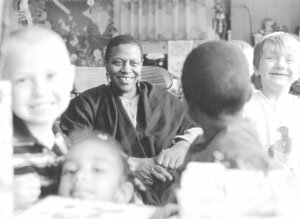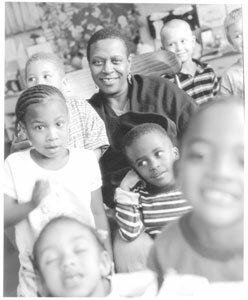Joan Woodfolk recalls Vinegar Hill
We meet at the Jefferson Preschool, the first building that comes to Joan Woodfolk's mind when I ask for a place that will evoke her childhood memories of Vinegar Hill.
We decide to visit a classroom, to bring the memories out from inside.
Joan Woodfolk, tall, regal, head close-shorn, earrings dangling: a commanding presence. She keeps telling me whom I should talk to instead of her. "I was just a child here," she says. She wants me to talk to the older folks, who lived their adult lives on Vinegar Hill.
For a few minutes we stand and look out the schoolroom window together. She recalls a church, another school building, houses all down the hillside, Brown Street running alongside.
"When we left school, we just walked home," she says. Her thoughts turn too the neighborhood around the school building. "I remember Scott Dean's, around the corner," she says. "Best hot dogs I've ever had." She recalls the barber shop and the dentist's office, the music studio where Mr. Smith taught her sister to play the piano. When I ask her which teachers she remembers best, she names Mrs. Coles, Mrs. McGinniss, Mrs. Chisholm, Mr. Gaines, Mrs. Yancey. "Or was that in eighth grade?" she asks out loud. She and her older brother went to Jefferson School through eighth grade, then on to Burley.
I am struck by the people who live in her memory. The Vinegar Hill she remembers is not a place, not a collection of buildings, but a community of people who knew and loved and cared about each other. "If you were from here, we all knew each other," says Woodfolk. "When I think of this place in those days, I think of a sense of community."
"Your teachers were not only your mentors, but they were your extended family. All the teacher needed to do was look at a chair, and if you weren't in that chair they would call your parents, even call them at work, and you didn't want that at all." She laughs and shows the wide, wonderful gap in her front teeth, that broad smile, those thoughtful eyes."
"It's so powerful to see a group of people working," she says, thinking back to the many businesses that made Vinegar Hill throb with life and commerce. "Even if the buildings may not have been owned by those black people, I could look around and think, ‘there is someone who looks like me who owns a business and is profiting from it.'"
We look out the window to see spring in the treetops. It makes Woodfolk remember May Day at Jefferson School. Boys and girls would dress in white and weave banners around the pole, ducking in and out, braiding those ribbons in celebration of friendship and the season.
These are memories in which she loves to dwell, I can feel it. Vinegar Hill was where the heart was. "Society said we were poor— but we were so rich in history, in the sense of family, in the love we felt from our teachers," says Woodfolk. "It was powerful. You are who you are."

PHOTO BY JEN FARIELLO

PHOTO BY JEN FARIELLO
#